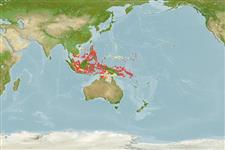>
Eupercaria/misc (Various families in series Eupercaria) >
Nemipteridae (Threadfin breams, Whiptail breams)
Etymology: Pentapodus: Greek, pente = five + Greek, pous = feet (Ref. 45335).
More on author: Bloch.
Environment: milieu / climate zone / depth range / distribution range
Ökologie
seewasser riff-verbunden; tiefenbereich 2 - 30 m (Ref. 9785). Tropical; 31°N - 16°S, 102°E - 166°E (Ref. 3810)
Western Pacific: Solomon Islands, New Guinea, western Caroline Islands (Palau, Yap), Philippines, East Malaysia, Indonesia and Singapore. This species has previously been misidentified as Pentapodus caninus by most authors.
Size / Gewicht / Alter
Maturity: Lm ? range ? - ? cm
Max length : 28.0 cm TL Männchen/unbestimmt; (Ref. 90102); common length : 15.0 cm SL Männchen/unbestimmt; (Ref. 3810)
Rückenflossenstacheln (insgesamt): 10; Rückenflossenweichstrahlen (insgesamt): 9; Afterflossenstacheln 3; Afterflossenweichstrahlen: 7. Some geographical variations. In Sulawesi shows yellow band intermittently because of other similar species in the same area (Ref. 48635). Head scales reaching forward to or just in front of level of anterior margin of eyes. Suborbital naked except for a small patch of scales beneath eyes. Lower limb of preopercle with 2 or 3 scale rows. Pelvic fins moderately long, reaching almost to level of anus. Axillary scale present. Color: Upper body dark grey or olive-brown, silvery white below. Presence of a narrow silvery white stripe joining eyes across snout just behind nostrils. Base of pectoral fin with a black bar.
Clear coastal to outer reef crests (Ref. 48635). Common in shallow sandy rubble and coral reef areas. Usually in aggregations. Feeds on small fishes, crustaceans and polychaetes during the day (Ref. 9710).
Life cycle and mating behavior
Geschlechtsreife | Fortpflanzung | Ablaichen | Eier | Fecundity | Larven
Russell, B.C., 1990. FAO Species Catalogue. Vol. 12. Nemipterid fishes of the world. (Threadfin breams, whiptail breams, monocle breams, dwarf monocle breams, and coral breams). Family Nemipteridae. An annotated and illustrated catalogue of nemipterid species known to date. FAO Fish. Synop. 125(12):149p. Rome: FAO. (Ref. 3810)
IUCN Rote Liste Status (Ref. 130435)
Bedrohung für Menschen
Harmless
Nutzung durch Menschen
Fischereien: kleinfischerei
Mehr Information
NamenSynonymeMetabolismusRäuberÖkotoxikologieFortpflanzungGeschlechtsreifeAblaichenSpawning aggregationFecundityEierEientwicklung
ReferenzenAquakulturAquakultur ProfilZuchtlinienGenetikElectrophoresesVererbbarkeitKrankheitenVerarbeitungNutrientsMass conversion
PartnerBilderStamps, Coins Misc.LauteCiguateraGeschwindigkeitSchwimmstilKiemenoberflächeOtolithsGehirngrößeSehfähigkeit
Tools
Zusatzinformationen
Download XML
Internet Quellen
Estimates based on models
Preferred temperature (Ref.
123201): 27.8 - 29.3, mean 28.8 °C (based on 1711 cells).
Phylogenetic diversity index (Ref.
82804): PD
50 = 0.5002 [Uniqueness, from 0.5 = low to 2.0 = high].
Bayesian length-weight: a=0.01950 (0.01104 - 0.03443), b=3.02 (2.87 - 3.17), in cm total length, based on LWR estimates for this species & (Sub)family-body (Ref.
93245).
Trophic level (Ref.
69278): 3.6 ±0.53 se; based on food items.
Widerstandsfähigkeit (Ref.
120179): hoch, Verdopplung der Population dauert weniger als 15 Monate. (Preliminary K or Fecundity.).
Fishing Vulnerability (Ref.
59153): Low vulnerability (18 of 100).
Nutrients (Ref.
124155): Calcium = 58.1 [36.6, 118.6] mg/100g; Iron = 0.656 [0.323, 1.605] mg/100g; Protein = 19.1 [17.2, 20.8] %; Omega3 = 0.146 [0.089, 0.241] g/100g; Selenium = 27.2 [16.1, 48.9] μg/100g; VitaminA = 76.5 [21.9, 221.6] μg/100g; Zinc = 1.26 [0.88, 1.82] mg/100g (wet weight);
